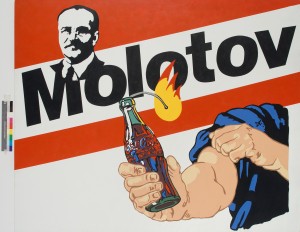These two images are artistic representations of Soviet sots-art and Russian Post-Modernism. Can you guess which is which?
If you guessed the left as Russian Post-Modernist and the right as sots-art then you were right.
In our recent reading of Dobrenko, he asserted that there is no such thing conceptually as “Russian Post-Modernism,” merely calling the moniker as a “slip of the pen” by critics and theorists. When confronting myself with the problem of the existence/nonexistence of Russian Post-Modernism, I was inclined to agree with Dobrenko. Traditionally, Russian culture has been but an almost mirror image of the Western model, in an attempt to downplay the barbarism associated with the East. Yet, going as far as calling the Post-Soviet art movement nothing but an extension of existing Soviet styles must be too far, right?
Wrong. As can be seen from the juxtaposition of these two artworks (one made during 1980s Glasnost, and the other in 2001 by Alexander Kosolapov), there is very little contextual difference. This is too be expected from the Russian Post-Modernist, because of the rejection of Capitalism because of what it had done to Russian society. This artist sardonically placed a Coca-Cola ad (a universally Capitalist symbol) next to the image and famous quote of Jesus Christ (a universally religious symbol), possibly equating the rise and spread of Capitalism to that of Christianity, which also bore harsh consequences for those willing to accept its religious guidance. The Sots-art image on the other hand depicts Rosy the Riveter holding a lit Molotov cocktail (made coincidentally in a Coca-Cola bottle) on the carton of a Molotov (Marlboro) box of cigarettes, with Vyacheslav Molotov’s image crudely pasted over it just for effect. Perhaps this image is suggesting the weakening of the control of the Soviet Union by contrasting a member of Stalin’s administration (one starkly opposed to Capitalism and the West) to global advertisements of Capitalist ventures in more of a power position in the artwork ; perhaps it is foreshadowing the explosion of Capitalism that was to take place after the fall of Communism, a Capitalist “revolution” of sorts. For the effect of this blog, I will not be going into that, merely trying to reinforce Dobrenko’s point that Post-Soviet and late-Soviet art are rather concurrent, and that Sots-art carried over into this Russian “Post-Modernism.”
Both of these artworks are deeply steeped in the pop art style that had been prominent in the West, which played off culturally popular images such as advertisements. In the East, pop art became a new valve for the release of opposition to the Soviet Union, and these artists applied social, political, and economic overtones to the artwork. Yet, as critics of Dobrenko would suggest, Russian Post-Modernism is not just an extension of this Sots-art, but a new entity all its own. As I stated earlier, I would be disinclined to agree with these critics, and very inclined to agree with Dobrenko. From my own Google image search, I found very few examples of non-pop-art Russian Post-Modernist artwork that dated past the fall of the Soviet Union. The one image I did find is the one I have presented above, made by an artist who was also coincidentally popular during the Glasnost era. Thus, in regards to Dobrenko’s postulation on the non-existence of Russian Post-Modernism, I believe him to be quite right.
Reflective Tag: I found this reading to be much more stimulating than many of the others, and it presented a new thought that had previously slipped my grasp. It presented a very interesting outlook on the Russian Post-Modernist “movement,” claiming it to be more of a stagnation than a movement. This presented yet another interesting view of the development of contemporary art in the Eastern bloc countries, which seems to be something very different for each individual country.


Your post has a lot of interesting points, but some questions you brought up: Do you think it is it fair/right to call Russian culture barbaric? Also: did Russia really reject capitalism? It seems that they wholeheartedly embraced it. Note that Kosolapov was a sots-art artist(!) Also, note that not all postmodernism looked at/used pop culture images, and the author is a SHE 🙂 A very interesting point you bring up in your reflective tag: how did this “post-0modernism” manifest itself in the different countries in the eastern bloc. Piotrowski claims each locality had a different take/manifestation. What was the manifestation of post modernity in Ukraine?